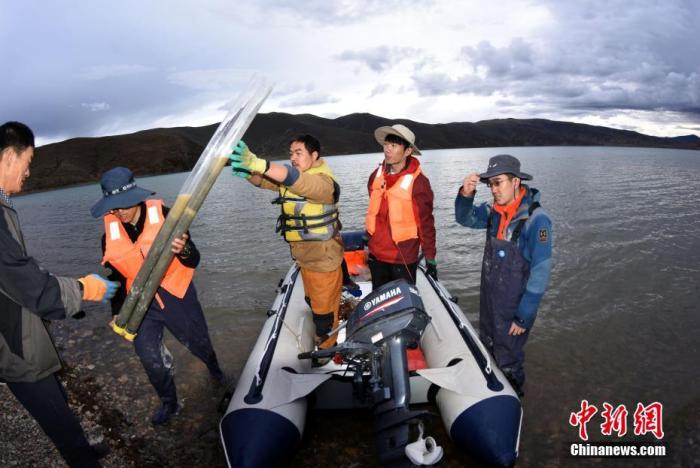Chinanews.com, Angren County, Tibet, July 17th (Reporter Sun Zifa) China's second comprehensive scientific expedition to the Qinghai-Tibet Plateau (Second Qinghai-Tibet Scientific Expedition) "Human Activity History and Its Impact" scientific expedition team arrived on the evening of the 16th. The first inspection site-Langcuo, a plateau lake at an altitude of 4,300 meters in Angren County, Xigaze City, Tibet, and the sampling work was successfully completed.
The picture shows the scientific expedition team members preparing to take a speedboat to the Langcuo Lake Center to carry out scientific expeditions.
Photo by China News Agency reporter Sun Zifa
Ji Kejia, a member of the scientific expedition and a doctoral student at the Institute of Tibetan Plateau Research of the Chinese Academy of Sciences (Tibetan Plateau Institute of the Chinese Academy of Sciences), said that the scientific expedition sampling in Langcuo was carried out at a depth of 29.5 meters close to the center of the lake, and a gravity drill sampler was used to obtain lake sediment cores. Three roots are 75, 80, and 90 cm in length. Based on previous studies, it is estimated that the bottom age is more than 1000 years; in addition, several surface sediment samples were collected at water depths of 22.5 meters and 12.5 meters.
A member of the scientific expedition, Dr. Xie Haichao from the Institute of Tibetan Plateau of the Chinese Academy of Sciences, said that the core and surface sediment samples of different water depths collected in Langcuo that day were mainly used to study the lake’s climate change and the lake’s aquatic ecological changes over the past millennia. It has attracted much attention for understanding. The characteristics of the "Anthropocene" on the Qinghai-Tibet Plateau provide basic data, as well as background data on the living environment for studying human activities in the historical period of the Yajiang River Basin.
The picture shows the scientific expedition team members who successfully completed the wave sampling and returned with a full load.
Photo by China News Agency reporter Sun Zifa
The 18 scientific expedition members of the second Qinghai-Tibet scientific expedition "history of human activities and their influence" set off from Lhasa early that morning, drove nearly 500 kilometers westward, and arrived at Langcuo, Angren County at 18:00 in the evening. The expedition members did not take care of them. After rest and recuperation, the inflatable speedboat assembly, sampling equipment commissioning and other preparations were immediately put in. Five scientific expedition team members then took the scientific expedition equipment and went to the center of Langcuo Lake by boat. After more than 2 hours of water work, they successfully completed the work at 21 o'clock. The first high-altitude lake sampling task in this scientific expedition.
According to the plan, the scientific expedition team will continue to march westward on the 17th and is expected to arrive at the next scientific investigation site Gongzhucuo, which is nearly 700 kilometers away from Langcuo, on the 18th.
The picture shows the beauty of Langcuo in summer.
Photo by China News Agency reporter Sun Zifa
It is understood that there are 19 large and small lakes scattered in Angren County, and as many as 11 lakes with a water area of more than 5 square kilometers. Langcuo is one of them.
Langco is located in the southeastern part of Angren County. It extends east-west with a length of 6,900 meters, a maximum width of 2,300 meters, an average width of 1,750 meters, and an area of 12.1 square kilometers. National Highway 219 passes through the north bank of Langco.
(Finish)

